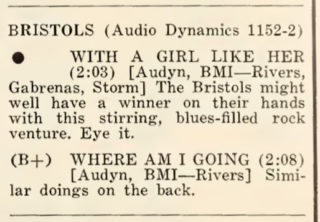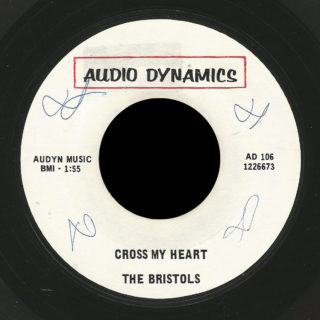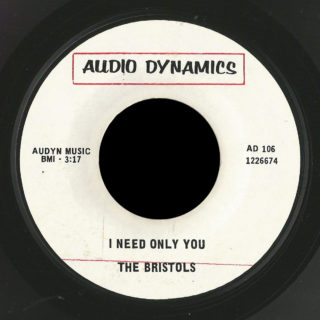
From Holyoke, Massachusetts, the Buck Rogers Movement cut three singles on their own 21st Century Records label in 1967 and 1968, then continued for a couple more years until tragedy struck.
The first mention of the band I can find comes from the Holyoke Transcript-Telegram on September 20, 1967, noting the group “formed only three months ago”.
The group is somewhat unusual in that it has two married couples within its membership: Roderick Trembley, lead guitarist, Mrs. Cynthia Trembley, rhythm guitar; Buck Rogers, sax; Mrs. Beverly Rogers, organ. Also members of the group are: Carl Larson, bass and William Wanat, drums.
Rod Trembley came out of a Chicopee band called the Del Vicounts, who competed in the Jaycees Western Massachusetts Regional band contest. Other members of the Del Vicounts included Tym McDowell, vocals; Pierre Provost, bass, George Barsalou, drums, and Michael Dubiel, rhythm guitar.

The Transcript-Telegram ran a photo of the Buck Rogers Movement on April 25, 1968, with some inconsistencies in spelling from the earlier article: Buck Roger, Beverley Roger, Cindy Trembley, Rod Trembley, Carl Larsons and Bill Wanat.
It claims “Buck holds an exclusive song writer’s contract with United Artists.”
“We like the clean sounds of the Buckingham[s] and The Young Rascals,” Buck says.
… they find time for bookings like the Showboat in New York City and a two-week tour in Labrador. The group has appeared at Mountain Park, the Catacombs, and at every Hullabaloo in New England.
The article notes Carl was a student at Chicopee Comprehensive High School and Rod Trembley attended Northampton Commercial College.

Copyright registration lists Buck Rogers real name as Herman Joseph Rogers, sometimes rendered as “Bucky Rogers” or Herman J. Rogers.
Registration dates are interesting, as some are a year or two before the recordings:
June 25, 1965: “You’ve Got Me Hurting Again”
Sept. 16, 1965: “Radio Station Commercial”
Oct. 19, 1965: “Here I Go Again”
Nov. 8, 1965: “Do Christmas Trees Really Grow?”
Nov. 22, 1965: “Come on Home”
Oct. 18, 1967: “Would You Believe?”
Nov. 8, 1967: “Take It From Me Girl”
WHYN DJ Dick Booth informed me he produced “Do Christmas Trees Really Grow” at Audio Dynamics in 1967, but not their other records. At the time he was booking them in shows around Springfield, MA and Stafford, CT.
21st Century Records 601: “Would You Believe” / “Baby Come Home”
21st Century Records 602: “Do Christmas Trees Really Grow” / “Music to Watch Christmas Trees Grow”
21st Century Records 603: “Take It From Me Girl” / “LA”

H.J. Rogers wrote all six songs, publishing the first two with Trish Music, and Unart Pub. on the third.
“Baby Come Home” was issued twice, the second time with the title changed to “Baby Come On” which sounds closer to what is being sung. Note that the signature on “Would You Believe” is Karl Larson, not Carl.
There was some local radio chart action, for example, “Would You Believe” reached #8 on WHYN on November 11, 1967, and “Take It From Me” reached #9 on the WAIC top ten on April 13, 1968.
At some point, Karl Larson left and was replaced by Ray Mason, who had just graduated high school.
The Atlanta Journal had a report on February 24, 1970 headlined Sniper Suspected of Earlier Attack:
Twenty-four hours out of Albany, N.Y., the Buck Rogers Movement was awake, anticipating arrival in Atlanta where they thought they had a contract to play rock music in a midtown nightclub.
Harlan Cornelius, the bearded, 24-year-old guitarist for the group was working on a list of songs the group could do, and discussing his choices with the rest of the group.
Buck Rogers, 29, the leader, was driving his gold convertible south on I-85, and turned on the car’s interior light so Harlan could see his list.
About 60 miles out of the city, a car whipped around the group’s rented trailer and pulled alongside. A young man inside hollered, “Fink.”
“There’s your ‘Easy Rider,'” Rogers said, remembering how the two motorcyclist in the movie had been scorned and abused by people who thought long hair and beards repugnant … he turned away the insult, and held up the two-fingered peace sign to the pair in the other car.
The car, a black compact – he thinks a Falcon – with lots of chrome, and raised on its axles, slowed down and allowed the group to pass. As they went by, one of the youths gave a vulgar finger signal in return.
Later, Rogers told the Atlanta Journal Tuesday, they saw the car parked alongside the road, with its two occupants standing at its opened trunk. “When we saw them parked, we thought they were getting a jack handle or something,” the band leader said.
You’d be surprised how much aware we were that something was going to happen – we definitely knew they were looking for trouble.”
Shortly after midnight, they found it. Rogers saw the car approaching in his rear view mirror. “I heard the first shot, then as he drove past, I saw the kid with his arm out the window.” Through the glass of his rolled up window, Rogers saw the flash of the gun, apparently aimed at his face.
“Then Harlan said ‘I’ve been shot; I’ve been shot,'” Rogers recalled. His wife, Beverly, turned around and saw blood coming from the guitarists nose. “He put his hand down and said he thought they’d gotten his eye, but I looked at it and said No, it’s still there,” she said.
Rogers said the shot that hit Harlan came through the cloth top of the convertible.”
“I think the way America is today, that’s the way things happen,” Rogers said. “Those two guys started something, and they just had to finish it.”
Detective W. Tony Crook said the same sniper may have been involved in a similar incident in DeKalb Count a week ago, when a shotgun blast was fired into a car as a woman was driving on I-20 …
Meanwhile the group waiting Tuesday in Atlanta for their companion, who will be in the hospital for a while. The job they thought they had didn’t pan out, and Rogers said he may have to wash dishes or drive a truck until they get another booking.
The group had just returned from a USO show in Laborador and Greenland.
For all their concern about the future, they are still mainly concerned about Harlan.
“He’s an easy-going guy, and he wouldn’t hurt a fly,” Beverly added. “After he was hit, he kept asking if Ray (Raymond Mason, 19, the bass guitar player) was all right,” she said. Ray had been sitting on Harlan’s right.
Police are working on the theory that the sniper just didn’t like people with long hair, and the Buck Rogers Movement does, indeed wear its hair long. “It’s the style that’s in with the music,” Rogers said. “You just can’t look like Bill Haley and the Comets.”
But sometimes it’s not a good idea to look like the Buck Rogers Movement.
The Journal followed up on February 25, noting the epithet shouted at the band was either “fink” or “freak” and noting the assailants’ car was a black Ford Falcon, and the second shot “penetrated the front door of the car”:
The rock guitarist wounded on the Northeast Expressway by a sniper definitely will lose the sight of his left eye, his father said Wednesday.
Harry Cornelius, in Atlanta with his wife to visit their wounded 24-year-old son, Harlan, said surgeons at Grady Memorial Hospital have not yet removed the bullet which struck their son Sunday night.
The bullet [entered] the musician’s skull near the left temple.
Harry Cornelius said his son never lost consciousness during the ordeal, although the wound was painful.
The Corneiliuses are from Glenville, Minn., a small town in the southern part of the state that has about 700 residents.
“I can’t understand how this could have happened. We don’t have anything like that in Glenville. Do you think the ones who did it could have been on drugs?”
The Springfield Union ran an article about a benefit at the Paramount Theater tonight to help a fund being collected for Harlan Corneilius and the Buck Rogers Movement “which calls itself ‘The White Soul Group'”.
The bullet his lodged in his sinus passages, and doctors at Grady Memorial Hospital … were still undecided whether to remove the bullet.
The groups performing tonight … are The Fat, The Glass, and Sin.
On May 5, 2000, the Daily Hampshire Gazette profiled local musician Ray Mason who “spoke about the shooting: ‘I was asleep in the back, and I woke up to see our guitar player with blood all over the side of his face'”.
The Atlanta Constitution gave a summary of the events on April 4, 1970:
On the night of Feb. 23, the Buck Rogers Movement was bound for Atlanta for an engagement of a local night club.
They stopped for gas near Commerce, Ga., and as the car entered the expressway, the car containing the assailants sped around the musicians’ car.
The driver of the musician’s car, “Buck” Rogers, said he held up two fingers in a peace sign.
Closer to Atlanta, the group noticed the car again, this time parked on the side of the expressway, and the two occupants were standing beside the open trunk.
As the musicians neared the North Druid Hills exit on I-85, the other car roared up again and one of the occupants fired into the musicians’ car, hitting Cornelius in the head.
DeKalb County police said Friday they have located two prime suspects in a case in which a rock musician was shot in the head while in a car with other musicians while coming into Atlanta on the Northeast Expressway. But, the pair will probably never stand trial for the offense, officers said.
Officers said the suspects had been bragging about the incident in the Paulding County community in which they live.
Location of the suspects followed a month-long investigation by Detectives C.H. Staples and Tony Crook …
But the musicians involved couldn’t agree on the description of the car from which the night rider fired, except that it had round tail lights and that it was raised in the rear end, police said.
Identification of the suspects by the victim or witnesses is necessary in this case before any further action can be taken, police said.
The rock group, the Buck Rogers Movement, has left the metro area to fulfill other engagements. “They had to make a living,” said Smith.
The victim, Harlan Cornelius who played lead guitar has returned to Minnesota.
 Although the group is noted as a sextet in these articles about the shooting, only four members are named: Buck and Beverly Rogers, Ray Mason and Harlan Cornelius. I suppose Ray Twombley and his wife had already left the group, and have not seen the drummer’s name listed.
Although the group is noted as a sextet in these articles about the shooting, only four members are named: Buck and Beverly Rogers, Ray Mason and Harlan Cornelius. I suppose Ray Twombley and his wife had already left the group, and have not seen the drummer’s name listed.
An obituary in the Leader Press noted that Harlan Cornelius passed away at age 35 on October 6, 1981. It noted Harlan performed with the USO, managed the Carlton Stewart Music Stores in Mason City and Waterloo, and entertained with Gordon Lennevold.
Harlan Cornelius played guitar, co-produced, and wrote three songs for Gordon Linn’s album Wild Oats, and played guitar, lap steel and banjo on Mike Price & the Townsmen LP, I Found You Last Night (And I Lost You Today).
The Buck Rogers Movement may have broken up soon after the shooting, as there are no further notices that I have found. I’d appreciate more info or photos of the band.


















































